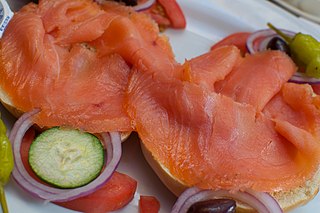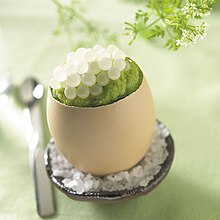
Clotted cream is a thick cream made by heating full-cream cow's milk using steam or a water bath and then leaving it in shallow pans to cool slowly. During this time, the cream content rises to the surface and forms "clots" or "clouts", hence the name. Clotted cream is an essential ingredient for cream tea.

Roe, or hard roe, is the fully ripe internal egg masses in the ovaries, or the released external egg masses, of fish and certain marine animals such as shrimp, scallop, sea urchins and squid. As a seafood, roe is used both as a cooked ingredient in many dishes, and as a raw ingredient for delicacies such as caviar.

Caviar is a food consisting of salt-cured roe of the family Acipenseridae. Caviar is considered a delicacy and is eaten as a garnish or spread. Traditionally, the term caviar refers only to roe from wild sturgeon in the Caspian Sea and Black Sea. The term caviar can also describe the roe of other species of sturgeon or other fish such as paddlefish, salmon, steelhead, trout, lumpfish, whitefish, or carp.

Lox is a fillet of brined salmon, which may be smoked. Lox is frequently served on a bagel with cream cheese, and often garnished with tomato, onion, cucumber, and capers.

Ukrainian cuisine is the collection of the various cooking traditions of the people of Ukraine, one of the largest and most populous European countries. It is heavily influenced by the rich dark soil (chornozem) from which its ingredients come, and often involves many components. Traditional Ukrainian dishes often experience a complex heating process – "at first they are fried or boiled, and then stewed or baked. This is the most distinctive feature of Ukrainian cuisine".

Beluga caviar is caviar consisting of the roe of the beluga sturgeon Huso huso. The fish is found primarily in the Caspian Sea, which is bordered by Iran, Azerbaijan, Kazakhstan, Russia, and Turkmenistan. It can also be found in the Black Sea basin and occasionally in the Adriatic Sea. Beluga caviar is the most expensive type of caviar, with market prices ranging from $7,000 to $22,000/kg.

Gloucester is a traditional, semi-hard cheese which has been made in Gloucestershire, England, since the 16th century. There are two varieties of the cheese, Single and Double; both are traditionally made from milk from Gloucester cattle. Both types have a natural rind and a hard texture, but Single Gloucester is more crumbly, lighter in texture and lower in fat. Double Gloucester is allowed to age for longer periods than Single, and it has a stronger and more savoury flavour. It is also slightly firmer. The flower known as lady's bedstraw was responsible for the distinctively yellow colour of Double Gloucester cheese.

Cypriot cuisine is the cuisine of the island of Cyprus, shared by both Greek Cypriots and Turkish Cypriots.

Saint-Nectaire is a French cheese made in the Auvergne region of central France.

The following outline is provided as an overview of and topical guide to the preparation of food:

Heliciculture, commonly known as snail farming, is the process of raising edible land snails, primarily for human consumption or cosmetic use. The meat and snail eggs a.k.a. white caviar can be consumed as escargot and as a type of caviar, respectively.

A land snail is any of the numerous species of snail that live on land, as opposed to the sea snails and freshwater snails. Land snail is the common name for terrestrial gastropod mollusks that have shells. However, it is not always easy to say which species are terrestrial, because some are more or less amphibious between land and fresh water, and others are relatively amphibious between land and salt water.

Sponge cake is a light cake made with eggs, flour and sugar, sometimes leavened with baking powder. Some sponge cakes do not contain egg yolks, like angel food cake, but most of them do. Sponge cakes, leavened with beaten eggs, originated during the Renaissance, possibly in Spain. The sponge cake is thought to be one of the first non-yeasted cakes, and the earliest attested sponge cake recipe in English is found in a book by the English poet Gervase Markham, The English Huswife, Containing the Inward and Outward Virtues Which Ought to Be in a Complete Woman (1615). Still, the cake was much more like a cracker: thin and crispy. Sponge cakes became the cake recognised today when bakers started using beaten eggs as a rising agent in the mid-18th century. The Victorian creation of baking powder by English food manufacturer Alfred Bird in 1843 allowed the addition of butter to the traditional sponge recipe, resulting in the creation of the Victoria sponge. Cakes are available in many flavours and have many recipes as well. Sponge cakes have become snack cakes via the Twinkie.
Caviar, sometimes Kaviar is, primarily, the name given to the luxury delicacy consisting of processed, salted, non-fertilized sturgeon roe.

Nanjing salted duck is a local duck dish from Nanjing, China. The history of the dish goes back hundreds of years, possibly to the 14th century, but it grew more famous during the Qing Dynasty. The tender white duck-meat has some fat but is not greasy, and in presentation the dish is fragrant and often crispy. Although available all year round, experts believe that duck in autumn inherently possesses a sweet scent of osmanthus and is therefore best in this season. In line with this statement, some cooked-meat product shops have started experimenting with the use of osmanthus to flavour duck. Nanjing salted duck prepared shortly before or after mid-Autumn is reputed to taste the best, because of duck production during the sweet osmanthus blooming season. Sometimes the seasonal version of the dish is called "osmanthus duck".
Kaluga Queen is a Chinese brand of caviar made by the caviar company Hangzhou Qiandaohu Xunlong Sci-Tech Co., Ltd. The company produces 60 tonnes of caviar annually, making it the largest producer of caviar in the world and responsible for 30% of world production. Kaluga Queen supplies caviar for 21 of the 26 3-starred Michelin restaurants in Paris.
Russian Caviar House is a Russian group of companies that grows sturgeon and sells black caviar. It is Russia's largest producer of black caviar.

Snails are considered edible in many areas such as the Mediterranean region, Africa, France and Southeast Asia, while in other cultures, snails are seen as a taboo food. In American English, edible land snails are also called escargot, taken from the French word for 'snail', and the production of snails for consumption is called snail farming or heliciculture. Snails as a food date back to ancient times, with numerous cultures worldwide having traditions and practices that attest to their consumption.

The Caviar of Kladovo was a type of caviar produced in eastern Serbia. It was named after the town of Kladovo, in central Serbia, part of the Danube's Iron Gates Gorge between Serbia and Romania. Made from various fishes' roe, the caviar was granted the protected geographic designation and was considered an expensive delicacy, which was even served on the RMS Titanic. With the construction of large dams in 1972 and 1984, jointly by the two states, the fish migrating from the Black Sea upstream the Danube were prevented from reaching their old spawning areas, and production of caviar was discontinued in the 21st century.
















